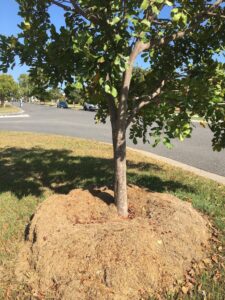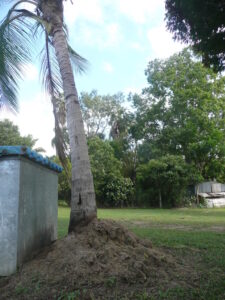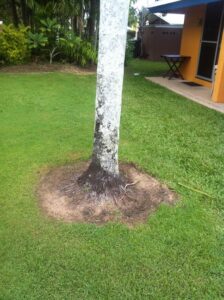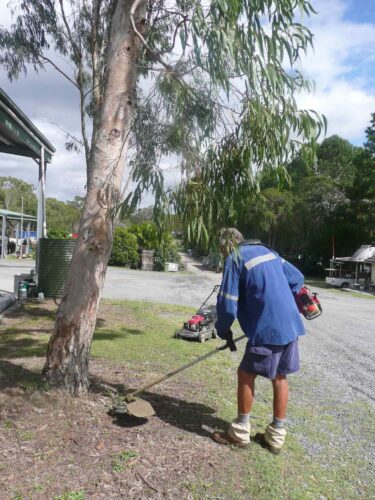You could say that cleaning up the yard on the weekend is part of our Australian culture. Every weekend, out comes the lawnmower, whipper snipper, along with herbicides to kill off any offending weeds. Yes, the lawn looks great, but have we thought about what damage we may be causing to the trees?
Trees make a major contribution to a garden’s ambience and beauty. They cool down the heat island effects of suburbia, remove atmospheric pollutants, and provide shade for children to play, and food and shelter for native wildlife.
Trees treated with care have so many benefits for future generations but their life span can be drastically shortened by human interference. Often trees are damaged unwittingly at the expense of having the perfect lawn. One of the most common problems is trunk damage from mowers and whipper snippers coming too close. Repeatedly banging a mower against a tree trunk or whipping it senseless with a weed whip each week can seriously damage the bark and the sensitive tissues underneath.
All tree wounds are serious when it comes to tree health. No matter what size the wound is, the damage done is irreversible. Tree growth relies on nutrients being transported through the cambium layer just underneath the bark. Once the cambium layer is cut, it may never completely heal or compartmentalise (your local arborist will be able to advise).
Even when a tree tries to recover from a wound, leaves and branches often decline and die back because food and water pathways were destroyed. The tree must devote a great deal of energy and many resources into trying to seal off the damaged area to prevent further complications. The wounded area is an opening for wood-rotting organisms and decay fungi to enter and cause further damage. These microorganisms often attack the injured bark and invade adjacent healthy tissue, greatly enlarging the wound. Trees can be completely girdled from pathogen attack following injuries.
Never cut closer than 150 mm and remember that young, thin-barked trees are particularly vulnerable to weed trimmer injury. The bark layer can vary in thickness on different tree species. It can be more than an inch in thickness or less than 1/16 of an inch on young, smooth-barked trees.
The best way of dealing with grass around trees is to remove it by hand; a thin layer of leafy grass cuttings can be placed over the bare soil until mulch is available. Mulch should be a suitably sized mixed particle no deeper than 75mm, and spread over a few layers of dampened newspaper sheets to prevent weed growth.


Lawn clippings can cook trees
While it may be convenient to empty mower catchers around tree trunks on footpaths or nature strips, it brings no end of frustrations to Council arborists whose job it is to keep avenues of trees healthy. Over time, lawn clippings piled around the base of a tree can heat up and rot vital tissue at the root collar. Once decayed, serious disease organisms may more readily enter the plant. Other problems arising:
- Residual traces of lawn products (monocots) in grass cuttings is harmful to trees (dicots).
- Rising of soil temperature under the tree promotes development of disease.
- Oxygen level to tree is decreased.
- Water infiltration to root zone is reduced by dense mat overlay.
Councils are encouraging residents who unable to find uses for lawn cuttings to utilise their green waste service.

Arborist calls for changes to herbicide practices
Modern arboriculture recognises that tree decline or death is generally caused by multiple factors working against the tree as one. Conservation arborists say using herbicides around trees is a practice that needs to be replaced by a more sustainable means of landscape maintenance.
In a recent article in the Australian Arbor Age magazine, arborist Cassian Humphreys warned against non-sustainable land management practices that are largely driven by horticulture, agriculture and non-sustainable development.
The well-travelled arborist said, around the world, he has seen the same standard of a collective lack of tree care with most amenity trees seldom living beyond the first third of their lifespans.
“When we consider the long term economic and environmental costs of managing trees, non-sustainably verses sustainable, the benefits are multifaceted. To create the precedent for conservation arboriculture, we need good local government support. The problem is getting tree and people managers to start to change.
“Arboricultural experience supports the symptoms of rapid tree death to herbicide use. Bearing in mind that the herbicide companies downplay the side effects of the products they sell, I am more inclined to pay attention to field experience than the ‘literature’ on this topic,” Cassian said.
Professional arborist reports can help identify the environmental impacts of herbicide practices and keep your home and environment thriving.
AUTHOR: GAIL BRUCE
Gail is passionate about the restoration and preservation of Australia’s precious flora.
She has a Bachelor of Communication and Certificate III in Conservation and Land Management, and her work in local koala conservation was recognised when she was awarded Redland City Council’s Environment Award in 2000.
Gail is well known in Arborist circles, being a regular contributor to Australian Arbor Magazine, Redland City Bulletin, as well as Public Relations Officer for Redland Organic Growers Incorporated.

